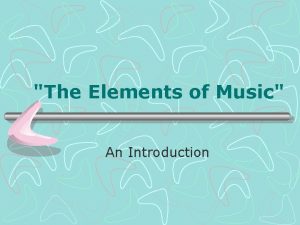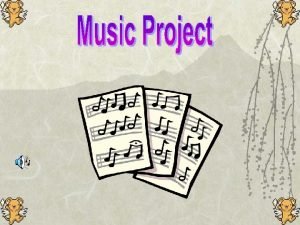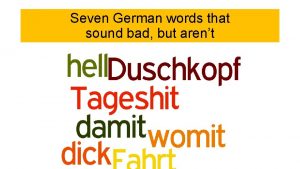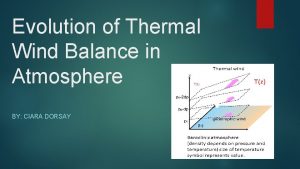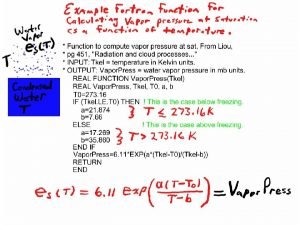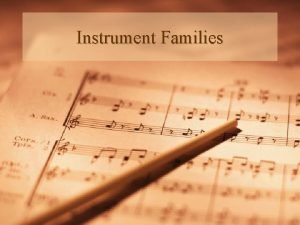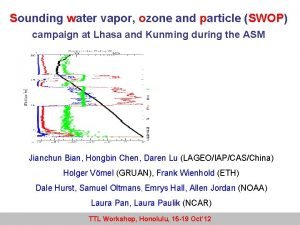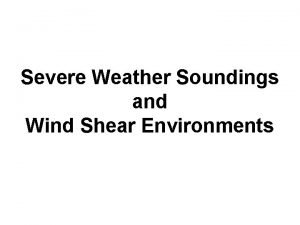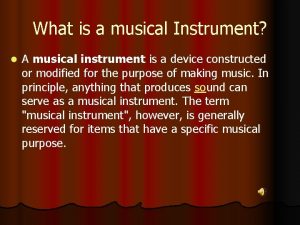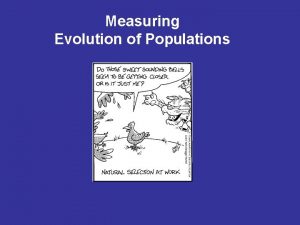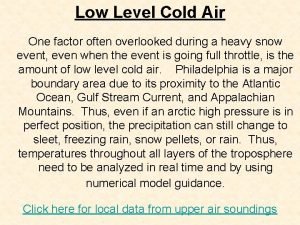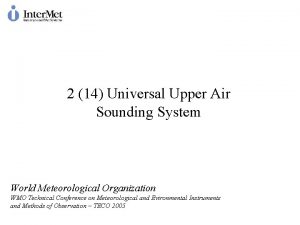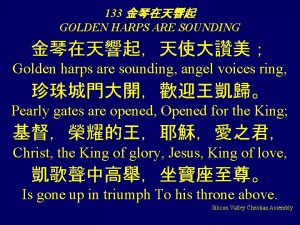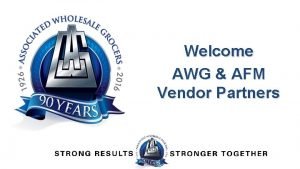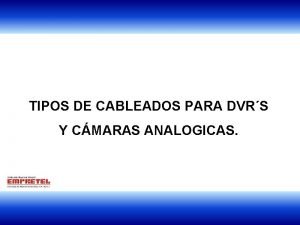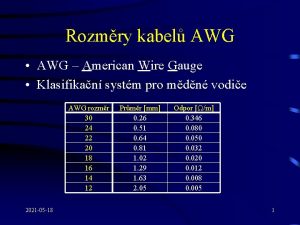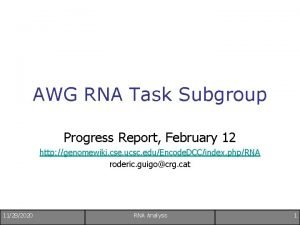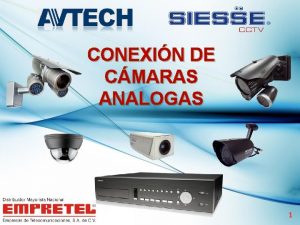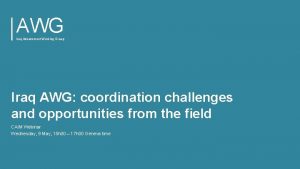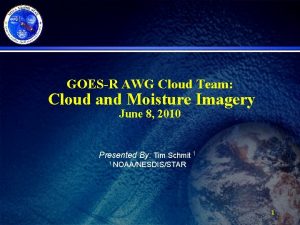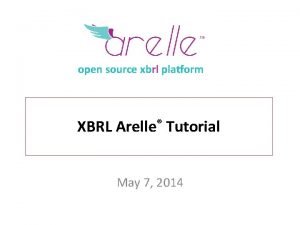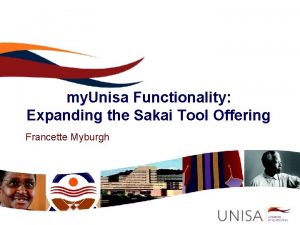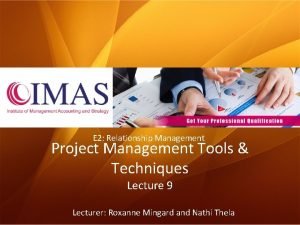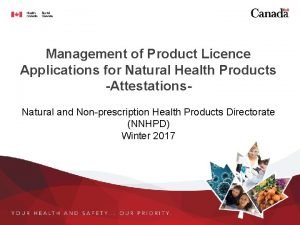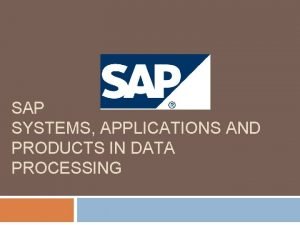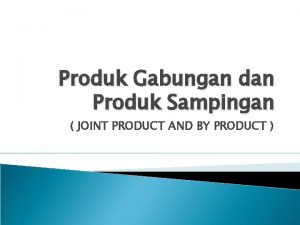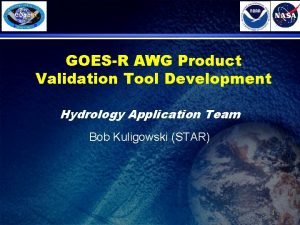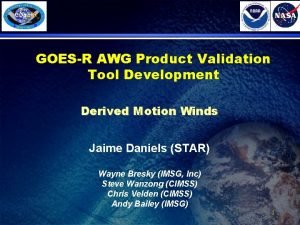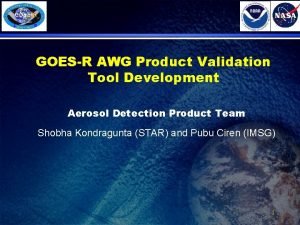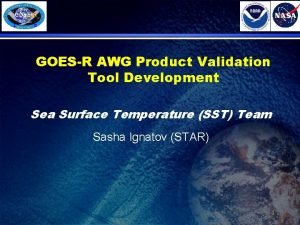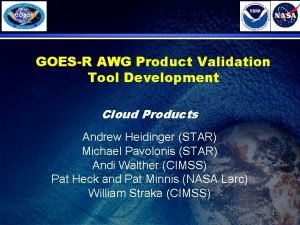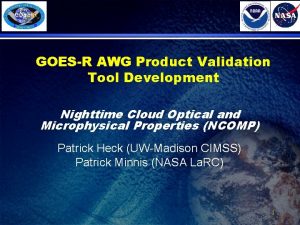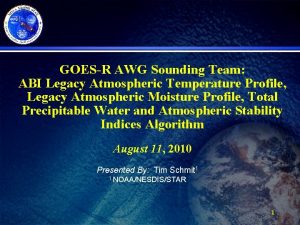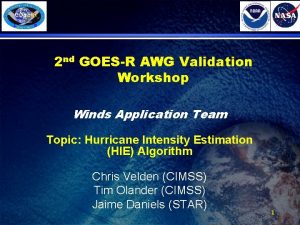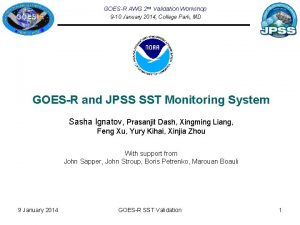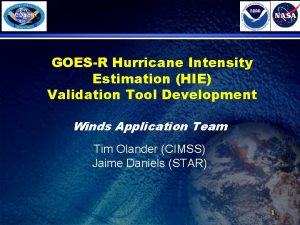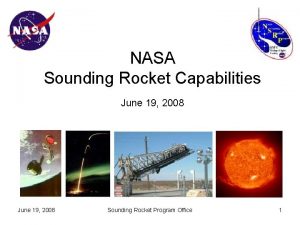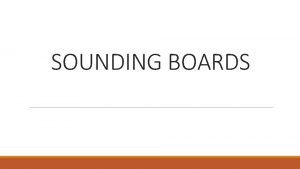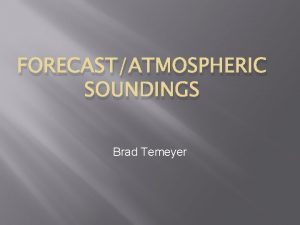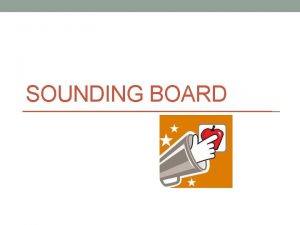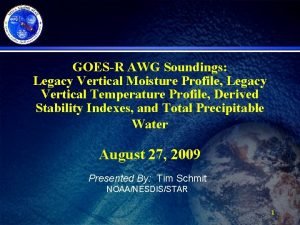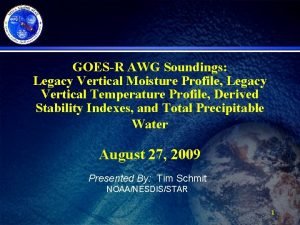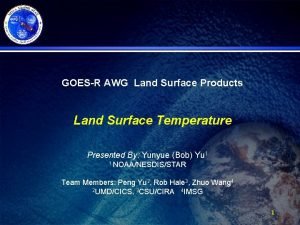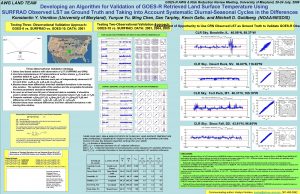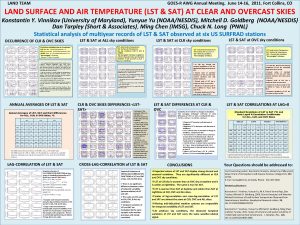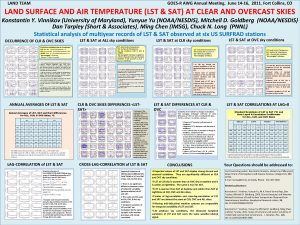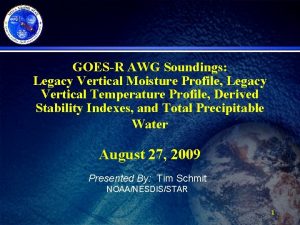GOESR AWG Product Validation Tool Development Sounding Application
































- Slides: 32

GOES-R AWG Product Validation Tool Development Sounding Application Team Tim Schmit (STAR) with contributions from many others, such as Jun Li, Zhenglong Li, Jinlong Li, Xin Jin, Seth Gutman, Eva Borbas, Wayne Feltz, Ralph Petersen, etc. 1

Products • Legacy atmospheric temperature profile (10 km, hourly, disk) • Legacy atmospheric moisture profile (10 km, hourly, disk) • Total precipitable water (10 km, hourly, disk) – Layered PW only an intermediate product • • • Lifted index (10 km, hourly, disk) Convective available potential energy (10 km, hourly, disk) Total totals index (10 km, hourly, disk) Showalter index (10 km, hourly, disk) K-index (10 km, hourly, disk) 3

Example LAP Output using Simulated ABI data TPW and layered PW Totals Lifted Index K Index Convective Available Potential Energy Showalter Index 4

Validation Strategies • SEVIRI onboard MSG is good proxy for ABI LAP sounding validation • MODIS is proxy for ABI LAP validation over GOES-R domain (prelaunch) • GOES Sounder is proxy for ABI LAP validation over CONUS and adjacent region (pre-launch) • ECMWF 6 -hr analysis profile products are good for full disk evaluation • AMSR-E TPW product (AIRS, IASI, Cr. IS) as well • Operational conventional radiosonde dataset collected twice a day at WMO weather stations is the best for validation over land • ARM sites MWR TPW and radiosondes (4 times/day) have good quality for validating GOES-R LAP profiles and derived products • GPS-Met and WVSS 2 allows for monitoring other than 00 and 12 UTC The long-term dataset (radiosondes, ARM TPW and aircraft) makes it possible to validate the algorithm’s seasonal, diurnal, and latitudinal 5 performance, or the performance over different surfaces

Current GOES example LI TPW 6

Current GOES example http: //www. star. nesdis. noaa. gov/smcd/opdb/goes/soundings/html/stats 23 L. html TPW 7

Temperature/Moisture Profile Validation over Land The following images illustrate the temperature/moisture/TPW retrieval by SEVIRI against 475 radiosonde measurements over land for August 2006 TPW Sample sites Accuracy = -0. 3 mm and Precision = 2. 85 for TPW 8

Temperature/Moisture Profile Validation over Ocean The following images illustrate the temperature/moisture/TPW retrieval by SEVIRI against 149721 ECMWF analysis profiles over ocean for January 2008 RMSE (Precision) BIAS (Accuracy) Sample area 10

TPW Validation over Ocean • AMSR-E level-2 provides TPW over ocean. • Accuracy = 0. 4 mm • Precision = 2. 77 mm 11

Moisture Profile Validation over long term The following images illustrate the moisture profile retrieval by SEVIRI against ECMWF forecast and analysis profiles over all surfaces between April 2007 and September 2008 Improvement is trivial (0 to 3%) at low levels (below 700 hpa); Precision improves more than 5% at high levels (above 700 h. Pa); Algorithm performances better in winter than in summer Sample area 13

Routine Validation Tools Capabilities: - Monitoring the quality of atmospheric temperature and moisture profiles in near real time - Monitoring the quality of TPW, LI, TT, CAPE, KI, and SI in near real time Datasets used: Radiosondes (conventional, ARM site); ARM site microwave radiometer TPW; NWP forecast used in the LAP retrieval; ABI IR brightness temperatures Visualization and software tools (scripts + Mc. IDAS + Matlab) - Time series of BT difference (obs – cals (FCST)) images for ABI IR channels - Time series of difference (RTVL - FCST) images (TWP, LI, CAPE, TT, KI, SI) - Time series of LI, CAPE, TT, KI, SI from GOES-R RTVLs, FCSTs and radiosondes at ARM site - Time series of GOES-R TPW, FCST TPW, and MWR TPW at ARM site - Statistics of retrievals against conventional radiosondes over land - Statistics of retrievals against ECMWF analysis over ocean - Animations - Generate zoomed difference images - Monitor product quality 15 - Compare to other products (e. g. , Cr. IS)

GOES-12 Sounder TPW versus MWR at ARM site Legacy Compared with Phy 1: Regression microwave measured TPW at Phy 2: Forecast SGP ARM site from June 2003 to May 2005

GOES-12 Sounder TPW at ARM CART site - statistics 17

Time series of GOES-12 TPW (MWR VS forecast/retrieval) MWR FCST GOES Sounder SFOV GOES Sounder Spatial continuity GOES Sounder time continuity Physically retrieved TPWs from single FOV, spatial continuity and time continuity. The blue dots are microwave measured TPWs at Cart Site (36. 61 o, -97. 49 o). The cyan line is the first guess for physical retrievals. The green line is the physical retrieval with spatial continuity. And the red line is the physical retrieval with time continuity. Case study of 00 UTC on Dec 25 2005. 19

Sample ARM Site Timeseries 20

”Deep-Dive” Validation Tools • Capabilities: – Monitor any anomalies of any GOES-R LAP product and identify the cause – Quantify the error/uncertainty of GOES-R LAP products for better applications • Tools include, but is not limited to: – Full and/or zoomed difference (TPW, LI, CAPE, KI, TT, SI) between RTVLs and FCSTs images – Generate residual images (obs – cals from FCSTs) for each IR channel – Generate quality flag images – Times series of GOES-R TPW, FCST TPW and microwave radiometer TPW over ARM CART site • Longer times series – Daily statistics of temperature and moisture profiles against radiosondes (FCSTs, RTVLs) over CONUS • Longer times series – Individual IR brightness temperature images with calibration events – Cloud mask image – Aerosol/dust product images • Mc. IDAS + Matlab + scripts 21

Ob ser ved MT SA T IR 10. 8 μm Ima ges 6. 75 μm Cal cul ate d MT SA T IR Ima ges

GOES-13

GOES-15 BB event Stray light!

Time series of TPW (MODIS, GOES Sounder, MWR) Aqua MODIS (o) Terra MODIS (+) GOES Sounder (x) SGP MWR (·) 25

Time series of TPW (MODIS, GPS) 26

Validation of GOES-13 TPW using conventional RAOB Ma Li

GOES-GPS TPW Comparisons - CONUS Domain GPS allows for hourly comparisons 28

CONUS Avg TPW Differences for Case 1 This version of the Li algorithm doesn’t use a bias correction GPS allows for hourly comparisons Num # Sites Min Max Mean RMS GFS 0 h-GPS 16 273 -1. 099 0. 260 -0. 458 4. 059 Num # Sites Min Max Mean RMS GFS 3 h-GPS 16 274 -1. 195 0. 089 -0. 475 4. 084 Num # Sites Min Max Mean RMS Li-GPS 96 137 2. 160 6. 810 4. 785 6. 575 Num # Sites Min Max Mean RMS Ma-GPS 77 102 0. 920 5. 810 2. 858 5. 045 29

Ideas for the Further Enhancement and Utility of Validation Tools • The matchup data can be used for verifying an improved algorithm via re-processing just for the validation sites • The validation tools can be used to identify any radiance anomalies • The validation tools can be used to quantify the product uncertainties • JPSS soundings can be included for GEO/LEO comparisons • Comparisons to aircraft measurements of temperature and moisture, e. g. , the Water Vapor Sensor System (WVSS II). 31

Validating GOES Water vapor using existing data sources Objective: Use newly-available WVSS-II observations from commercial aircraft to validate GOES moisture products By end of 2011, 750+ soundings will be available daily from UPS and South. West Airlines aircraft - Choice of airlines provides good areal (SWA) and day/night (UPS) coverage Other data sources will also be explored, including RADAM Lidar observations from the ARM/CART site. Current daily WVSS-II sounding locations Funded by NWS and FAA – Endorsed by WMO Data from climate monitoring sites may provide additional validation of both GOES and WVSS-II

Routine Aircraft measurements 33

Routine Aircraft measurements 34

WVSS-II 2009 -10 Rawinsonde Inter-comparisons Specific Humidity (Excludes cases with large time and vertical rawinsonde differences) Systematic Differences: WVSS-II Biases at low levels of 0. 1 to +0. 4 g/kg from surface to 850 h. Pa. ± 0. 2 g/kg above Random Differences (Including Dry/Moist Environments): Differences between aircraft data and bounding rawinsonde reports generally showed variability of 0. 3 to 0. 7 g/kg from the surface to 600 h. Pa – decreases aloft. Std. Dev slightly larger than 1 -hour variability between bounding rawinsonde reports (gray shading). WVSS-II Data meet WMO quality standards.

2009 -2010 Aircraft-to-Aircraft Inter-comparisons Approximating WVSS-II Observational Error Restricted RMS calculated for: Time ranges of 0 -15, 15 -30, 30 -45 and 45 -60 minutes Distance ranges of 0 -15, 15 -30, 3 -45 and 45 -60 km Restricted RMSs show (ALL reports, Including Dry/Moist Environments): Atmospheric Variability more than doubles from 0 -15 to 30 -45 minute intervals Spatial Variability increase consistent, but not as regular as temporal Total Variability made up of 1) Instrument Error and 2) Atmospheric Variability Projecting for exact co-locations (ΔT~0 & Total Variability < 0. 2 g/kg), Expect Operational WVSS-II Instrument Errors should be ~0. 1 g/kg

Validating GOES Water vapor using existing data sources Objective: Use newly-available WVSS-II observations from commercial aircraft to validate GOES moisture products Proposed procedure: 1 – Establish infrastructure to validate GOES-R over the US 2 – Test current GOES products with WVSS-II to establish a baseline 3 – Compare GOES with data at other sites (ARM/CART and climate sites) 4 – Validate SEVIRI products against WVSS-II systems being mounted in Europe through the E-AMDAR program as an early surrogate for GOES-R

Summary • GOES-R LAP needs sufficient validation tools. Need a flexible system, which allows looping, customized time-series ranges, etc. • The tools should at least include: – Thumbnail of derived product images – Full size and/or zoomed derived images – Animations of the derived images – Times series of products at ARM site – BT difference images (obs – cals (FCST)) – Product difference images (RTVLS – FCSTs) – Statistics of RTVLs against radiosondes, other satellites, aircraft, NWP analysis, etc. • CIMSS MODIS validation experiment website: http: //cimss. ssec. wisc. edu/modis/mod 07/ • Current GOES Sounder experiment websites: http: //cimss. ssec. wisc. edu/goes/rt/sounder-dpi. php 38 http: //www. star. nesdis. noaa. gov/smcd/opdb/goes/soundings/html/stats 23 L. html
 8 elements of music
8 elements of music Smallest percussion instrument
Smallest percussion instrument Bad sounding words
Bad sounding words Http://weather.uwyo.edu/upperair/sounding.html
Http://weather.uwyo.edu/upperair/sounding.html Http://weather.uwyo.edu/upperair/sounding.html
Http://weather.uwyo.edu/upperair/sounding.html Five years have past five summers with the length
Five years have past five summers with the length Highest sounding double reed instrument
Highest sounding double reed instrument Sounding
Sounding Inverted v sounding
Inverted v sounding Afiw instrument drawing
Afiw instrument drawing Sweet-sounding
Sweet-sounding Sleet sounding
Sleet sounding Radiotheodolite
Radiotheodolite Golden harps are sounding
Golden harps are sounding Awg warehouse locations
Awg warehouse locations Tabla de awg amperaje
Tabla de awg amperaje Awg tabulka
Awg tabulka Awg aken
Awg aken Awg appointment scheduling
Awg appointment scheduling Cable 18 awg amperaje
Cable 18 awg amperaje Awg
Awg Awg cloud
Awg cloud Arelle
Arelle New product development and product life cycle strategies
New product development and product life cycle strategies Potter's wheel data cleaning tool
Potter's wheel data cleaning tool Unisa application tool
Unisa application tool Microsoft web application stress tool
Microsoft web application stress tool Product breakdown structure tool
Product breakdown structure tool Nnhpd monographs
Nnhpd monographs Systems, applications and products in data processing
Systems, applications and products in data processing Contoh produk bersama
Contoh produk bersama What is a firm
What is a firm Product line vs product width
Product line vs product width
